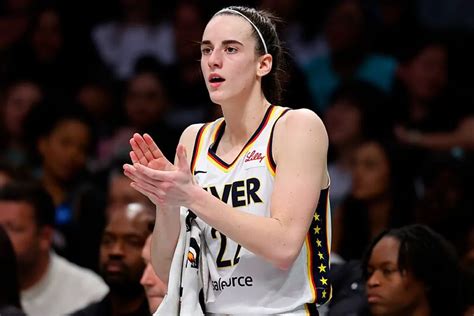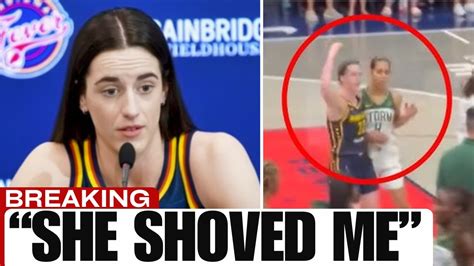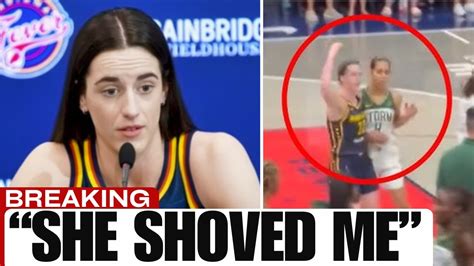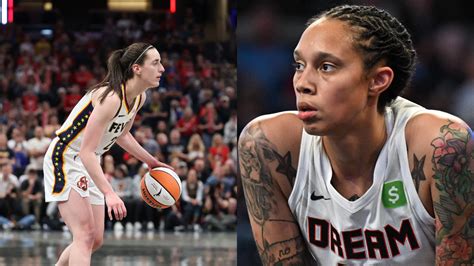
Caitlin Clark’s treatment in the WNBA has sparked a heated debate over whether she’s facing unduly physical play and insufficient protection from officials, igniting widespread discussions about league discipline and player safety.
The intensity surrounding Indiana Fever rookie Caitlin Clark’s entry into the WNBA is now extending beyond her on-court performance to encompass a growing controversy regarding the physicality she faces and the league’s response, or perceived lack thereof. A chorus of voices, including former players, analysts, and fans, are questioning whether Clark is being subjected to excessively rough play and whether the WNBA is adequately protecting its newest star. Calls for stricter discipline against players engaging in what some consider flagrant fouls are mounting, adding another layer of complexity to Clark’s already scrutinized rookie season.
The focal point of the debate stems from multiple incidents in recent games where Clark has been on the receiving end of aggressive plays. One particular instance during a game against the Chicago Sky, where Sky guard Chennedy Carter delivered a shoulder check to Clark that was later upgraded to a flagrant-1 foul, has become emblematic of the concerns being raised. While Carter was penalized, many argue that the initial response and subsequent league review were insufficient, failing to deter similar behavior in future games.
“People are talking about hard fouls. People are talking about targeting. People are talking about a different type of treatment,” former WNBA player and ESPN analyst Monica McNutt stated, encapsulating the sentiment of many observers. McNutt’s comments reflect a broader concern that Clark is not being treated like other rookies and is instead facing a level of physicality that borders on intentional targeting.
The debate is not simply about one or two isolated incidents but about a perceived pattern of behavior. Critics argue that the league’s historical tolerance for physical play, while a hallmark of the WNBA’s competitive nature, is now being exploited, with Clark becoming a focal point for excessive aggression. This perspective suggests that opposing players are intentionally testing the limits of what they can get away with, potentially to intimidate Clark and disrupt her game.
Adding fuel to the fire is the perception that the WNBA’s officiating crews are not consistently calling fouls when Clark is involved, further emboldening those who seek to impose their will physically. The lack of consistent foul calls, according to critics, contributes to a sense that Clark is not receiving the same protection afforded to other star players in the league. This perceived disparity in treatment is raising questions about fairness and whether the WNBA is inadvertently creating a hostile environment for its most prominent new player.
On the other side of the argument, some defend the physicality as simply part of the game. They argue that the WNBA has always been a league known for its toughness and that rookies, regardless of their pre-WNBA accolades, should expect a certain level of intensity from their opponents. This perspective suggests that Clark, like any other rookie, needs to adapt to the WNBA’s style of play and prove her mettle against seasoned veterans.
However, even those who acknowledge the league’s physicality concede that there is a line that should not be crossed. The concern is that the current level of aggression directed at Clark, coupled with the perceived leniency from officials, is creating a situation where players are incentivized to push the boundaries of acceptable play. This not only puts Clark at risk of injury but also undermines the integrity of the game.
The WNBA’s response to these concerns has been closely scrutinized. While the league has taken disciplinary action in some cases, such as the aforementioned flagrant foul assessed to Chennedy Carter, many feel that the measures have been too lenient and inconsistent. Critics argue that the league needs to send a stronger message that targeting and excessively physical play will not be tolerated.
“It’s a thin line between being physical and dirty,” said former NBA player Stephen Jackson, adding his voice to the growing chorus of those calling for greater protection for Clark. Jackson’s sentiment highlights the delicate balance between allowing players to compete with intensity and ensuring that the game remains safe and fair.
The situation is further complicated by the racial undertones that have emerged in some discussions about Clark’s treatment. Some observers have suggested that Clark, as a white player, is receiving preferential treatment or attention compared to her Black counterparts. Others argue that the criticism of Clark’s treatment is being downplayed or dismissed because she is white. These racial dynamics add another layer of complexity to the debate, making it even more difficult to find common ground.
Despite these complexities, one thing is clear: the debate over Caitlin Clark’s treatment in the WNBA is not going away anytime soon. As long as she continues to be the focal point of intense scrutiny and physical play, the calls for greater protection and stricter discipline will likely continue to grow. The WNBA faces a significant challenge in navigating this situation and ensuring that Clark, and all its players, are able to compete in a safe and fair environment. The league’s decisions in the coming weeks and months will be critical in shaping the narrative around Clark’s rookie season and the future of the WNBA.
Ultimately, the issue boils down to the WNBA’s commitment to player safety and the integrity of the game. While physicality is undoubtedly a part of basketball, there is a consensus that targeting and excessively rough play should not be tolerated. The league must take decisive action to ensure that its players are protected and that the game is played fairly, regardless of a player’s race, popularity, or experience level. The resolution of this debate will have far-reaching implications for the WNBA and its future.
The controversy also extends beyond the individual incidents and speaks to a broader issue within the WNBA: the evolving dynamics of competition and the pressure to perform. As the league continues to grow in popularity and attract more attention, the stakes are higher than ever. Players are under immense pressure to succeed, and this pressure can sometimes manifest in aggressive play and questionable tactics. The WNBA must address these underlying issues to ensure that its competitive spirit does not come at the expense of player safety and fairness.
Furthermore, the league must consider the impact of its decisions on its image and brand. The WNBA has made significant strides in recent years to attract a wider audience and establish itself as a premier professional sports league. However, the ongoing controversy surrounding Clark’s treatment threatens to undermine these efforts. The league must take swift and decisive action to restore confidence in its ability to protect its players and maintain the integrity of the game. Failure to do so could have lasting consequences for the WNBA and its future growth.
The debate is not only happening within the WNBA community but is also spilling over into mainstream media and social media. The widespread attention on Clark’s treatment has amplified the voices of those calling for change and has put additional pressure on the league to take action. The WNBA must be responsive to these external pressures and demonstrate a commitment to addressing the concerns being raised.
The situation is further complicated by the fact that Clark is a rookie. Rookies often face a period of adjustment as they adapt to the speed and physicality of the WNBA. However, Clark’s case is unique due to her pre-WNBA fame and the high expectations that have been placed upon her. This has created a situation where she is being targeted by opposing players who see her as a threat. The league must recognize this dynamic and take steps to ensure that Clark is given the opportunity to develop and succeed without being subjected to undue harassment.
Moreover, the WNBA must consider the long-term implications of its decisions on its relationship with its players. The league has a responsibility to create a culture of respect and fairness. If players feel that they are not being protected or that the rules are not being applied consistently, it could damage the league’s reputation and lead to resentment among the players. The WNBA must work to foster a positive and supportive environment where all players feel valued and respected.
In conclusion, the debate over Caitlin Clark’s treatment in the WNBA is a complex and multifaceted issue that requires careful consideration. The league must address the concerns being raised about excessive physicality, inconsistent officiating, and the potential for targeting. By taking decisive action to protect its players and uphold the integrity of the game, the WNBA can ensure that Clark, and all its players, are able to compete in a safe and fair environment. The future of the WNBA may depend on it.
The issue also highlights the different eras and the ever-evolving nature of the league. Former players often speak about the ‘old school’ mentality where physicality was not only accepted but expected. However, the game has evolved, and with increased media coverage and scrutiny, the tolerance for dangerous play is diminishing. The WNBA must reconcile these different perspectives and establish a clear standard for what is acceptable in the modern game. This requires a comprehensive review of the league’s rules and regulations, as well as ongoing training for players and officials.
The league’s response also needs to consider the message it sends to young girls and aspiring basketball players. The WNBA has a unique opportunity to serve as a role model for young athletes and to promote a culture of sportsmanship and respect. By taking a strong stance against excessive physicality and targeting, the league can send a powerful message that violence and intimidation have no place in the game.
Furthermore, the league needs to address the issue of social media and its impact on the players and the game. Social media can be a powerful tool for connecting with fans and promoting the WNBA, but it can also be a source of negativity and harassment. The league needs to develop strategies to protect its players from online abuse and to ensure that social media does not contribute to a toxic environment.
Ultimately, the debate over Caitlin Clark’s treatment in the WNBA is not just about one player or one incident. It is about the future of the league and its commitment to player safety, fairness, and integrity. The WNBA must take decisive action to address the concerns being raised and to ensure that all its players are able to compete in a safe and respectful environment. The league’s response will be closely watched by fans, media, and the entire basketball community.
The discussions surrounding Clark’s situation have also inadvertently highlighted the disparities in media coverage and fan engagement within the WNBA. While Clark’s arrival has undoubtedly boosted viewership and attendance, some argue that this increased attention should be leveraged to promote the entire league and its talented players, not just one individual. The challenge lies in finding a balance between capitalizing on Clark’s popularity and ensuring that all players receive the recognition they deserve.
The WNBA also faces the challenge of managing expectations surrounding Clark’s performance. As a rookie, she is still developing her game and learning the nuances of the professional level. It is important for fans and media to be patient and allow her the time and space to grow. The constant pressure to perform can be detrimental to her development and can contribute to the perception that she is being unfairly targeted.
The league’s communication strategy is also critical in managing the ongoing debate. The WNBA needs to be transparent and proactive in addressing the concerns being raised. This includes providing clear explanations of its disciplinary actions and its efforts to promote player safety. By communicating effectively with fans, media, and players, the league can build trust and demonstrate its commitment to addressing the issues at hand.
In addition to the specific incidents involving Clark, the debate has also sparked a broader conversation about the role of physicality in women’s basketball. Some argue that the WNBA has historically been more physical than the NBA, and that this physicality is part of what makes the league unique. Others argue that the level of physicality has crossed the line and that the league needs to prioritize player safety. This conversation is likely to continue as the WNBA evolves and as the game of basketball changes.
Furthermore, the WNBA must consider the impact of its decisions on its relationships with its corporate sponsors. Sponsors play a critical role in supporting the league and its players, and they expect the WNBA to maintain a positive and professional image. The ongoing controversy surrounding Clark’s treatment could potentially damage the league’s relationships with its sponsors and could make it more difficult to attract new sponsors in the future.
The WNBA also needs to address the issue of player compensation. While salaries have increased in recent years, they are still significantly lower than those in the NBA. This disparity can create tension and resentment among players and can make it more difficult to attract and retain top talent. The league needs to continue to work to increase player compensation and to create a more equitable system.
In conclusion, the debate over Caitlin Clark’s treatment in the WNBA is a complex and multifaceted issue that requires careful consideration. The league must address the concerns being raised about excessive physicality, inconsistent officiating, and the potential for targeting. By taking decisive action to protect its players and uphold the integrity of the game, the WNBA can ensure that Clark, and all its players, are able to compete in a safe and fair environment. The future of the WNBA may depend on it. The league’s actions in the coming weeks and months will be crucial in shaping the narrative around Clark’s rookie season and the overall perception of the WNBA.
FAQ:
-
What sparked the recent debate about Caitlin Clark’s treatment in the WNBA? The debate was sparked by a series of incidents where Clark was subjected to aggressive plays, particularly a shoulder check by Chennedy Carter of the Chicago Sky, which was later upgraded to a flagrant-1 foul. These incidents, coupled with perceived inconsistent officiating, led to widespread concerns about whether Clark is facing unduly physical play and insufficient protection from the league.
-
What are the main arguments from those who believe Caitlin Clark is being unfairly treated? Those who believe Clark is being unfairly treated argue that she is being targeted with excessively physical play, that officiating crews are not consistently calling fouls in her favor, and that the league’s disciplinary actions have been too lenient. They believe this combination creates a hostile environment for her and undermines the integrity of the game. As Monica McNutt stated, there are concerns about “hard fouls,” “targeting,” and “a different type of treatment.”
-
What is the counterargument from those who defend the physicality Clark is facing? Those who defend the physicality argue that the WNBA has always been a tough league and that rookies, regardless of their prior accolades, should expect a certain level of intensity from their opponents. They believe Clark needs to adapt to the WNBA’s style of play and prove her mettle against seasoned veterans.
-
What actions has the WNBA taken in response to the concerns about Clark’s treatment? The WNBA has taken disciplinary action in some cases, such as upgrading Chennedy Carter’s foul to a flagrant-1. However, many critics argue that these measures have been insufficient and inconsistent, calling for stronger action to deter future incidents.
-
What are the potential long-term implications of this debate for the WNBA? The debate could have significant long-term implications for the WNBA. If the league fails to address the concerns about player safety and fairness, it could damage its reputation, alienate fans, and make it more difficult to attract and retain top talent. Conversely, addressing these issues effectively could strengthen the league’s image and promote a more positive and supportive environment for all players.









